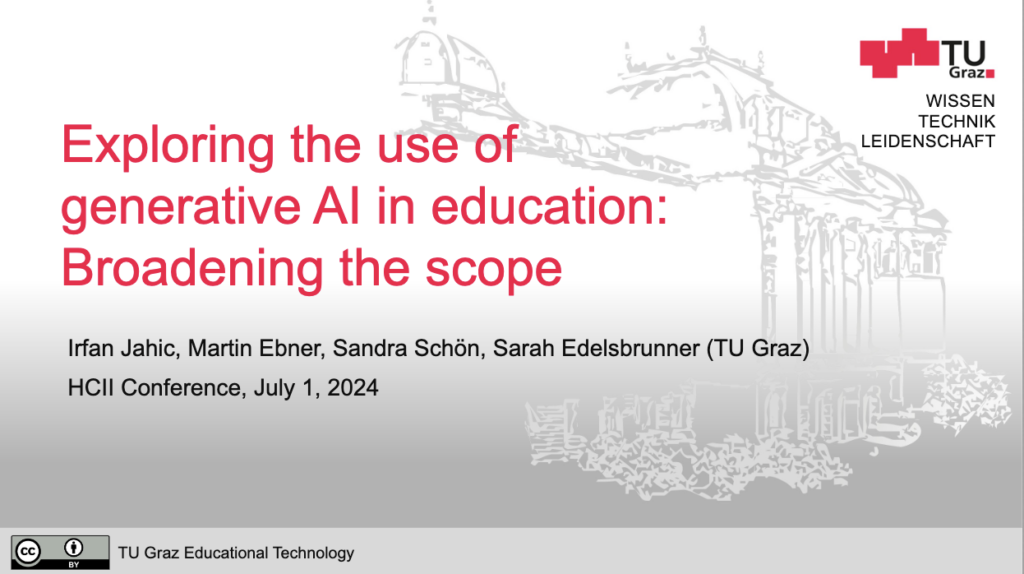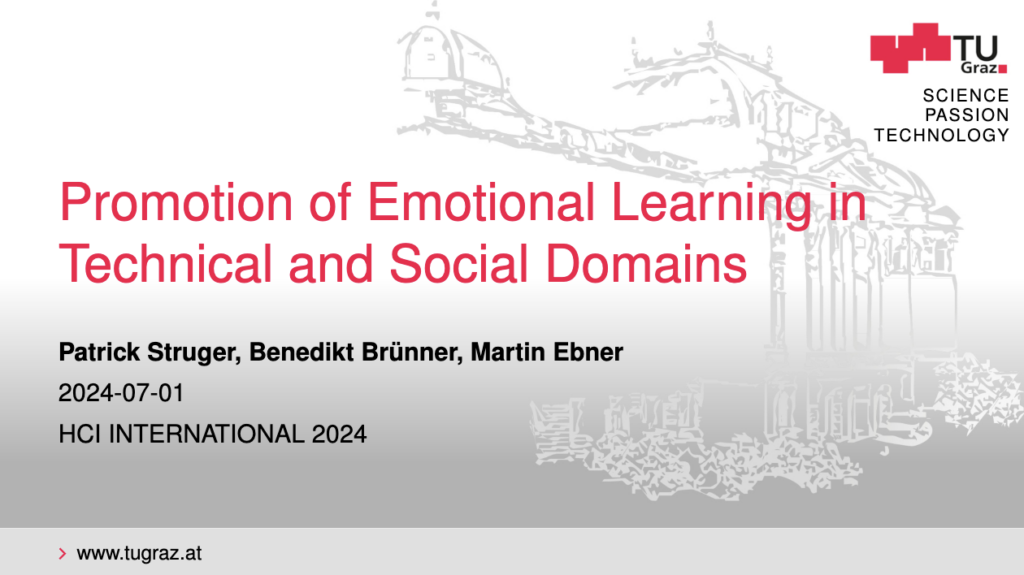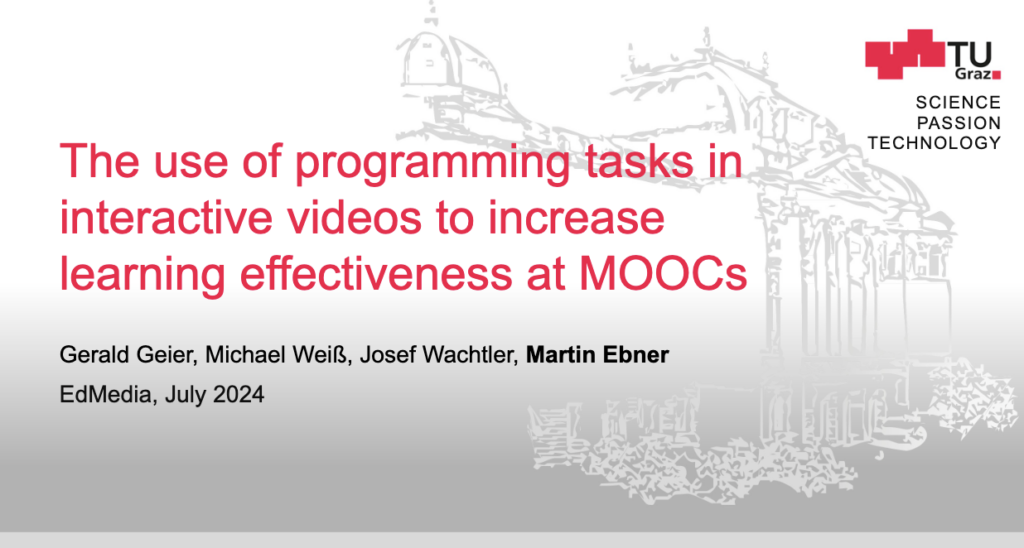Our presentation about „Exploring the Use of Generative AI in Education: Broadening the Scope“ done at this year’s HCII conference is now online available:


Digitale Lehre an und rund um der Technischen Universität Graz
Our presentation about „Exploring the Use of Generative AI in Education: Broadening the Scope“ done at this year’s HCII conference is now online available:

We presented our research at this year’s HCII conference, titled „Promotion of Emotional Learning in Technical and Social Domains„. Here you can find the slides

Our first presentation at this year’s ED-Media conference is „The use of programming tasks in interactive videos to increase learning effectiveness at MOOCs„. Find here our slides:

Our MOOC on „Open Educational Resources in Higher Education“ for the European alliance UNITE! is reaching the last week – number 4 :-). This time we are discussing the role of OER within Open Science and strategies for implementation in higher education:
And don’t to forget to change the language, all videos are offered in 11 different languages: [free registration link to the open course]
Our contribution titled „Supporting Sustainable and User-Oriented Educational Technology Innovation with the University Innovation Canvas“ was published in the newest issue of Education Sciences.
Abstract:
Innovating higher education teaching and learning is challenging due to structural, cultural, and resource-related reasons, and research indicates that university innovation benefits from a bottom-up approach as well as strategic alignment with university objectives. In this paper, we investigate such bottom-up innovation processes within higher education as supported by a specific tool: the University Innovation Canvas (UIC). Adapted from the Business Model Canvas and Lean Canvas, the UIC is designed to promote educational technology innovation and foster alignment of the innovation process with strategic objectives of the university: namely, sustainability and user orientation. An evaluation of the UIC based on interview and questionnaire data shows that its usage differs between innovation teams (on paper vs. digital, individual vs. collaborative, co-located vs. remotely, and synchronous vs. asynchronous). UIC usability is linked with these differences and with teams’ experience in realizing innovations. Overall, the UIC is perceived to be useful by (particularly, less-experienced) innovation teams and is successful at supporting sustainable and user-oriented innovations, as 14/15 innovations are still in use after up to four years since completion. To maximize its potential, more effort needs to be devoted to improving understanding of the UIC and supporting different workflows of innovation teams in the future.
[full article @ journal’s homepage]
[full article @ ResearchGate]
Reference: Bangerl, M.; Dennerlein, S.; Maitz, K.; Nitschke, M.; Ebner, M.; Pammer-Schindler, V. Supporting Sustainable and User-Oriented Educational Technology Innovation with the University Innovation Canvas. Educ. Sci. 2024, 14, 528. https://doi.org/10.3390/educsci14050528
Our article about „Analysis of Learners‘ Emotions in E-Learning Environments Based on Cognitive Sciences“ got published in the International Journal of Interactive Mobile Technologies (iJIM):
Abstract:
The present study aimed to examine students’ emotions in e-learning classes through facial expressions and investigate the influence of different instructional methods on students’ emotional responses. In this study, we examined the facial expressions of 17 undergraduate students using three different methods of presenting educational content (PowerPoint, video, and Kahoot) in online classes and analyzed the data with face reader software. The findings demonstrated that students experienced various positive and negative emotions with different methods of content delivery. Furthermore, comparing the three methods revealed that the Kahoot method elicited the highest average of positive emotions among students compared to the other two methods. This difference can be attributed to the visual attractiveness and interactive nature of the Kahoot environment. Additionally, this study highlights that simply incorporating multimedia materials, such as PowerPoint presentations and videos, is not sufficient to enhance effectiveness and cultivate positive emotions in e-learning. While multimedia materials serve as supportive tools and enhance visualization, interaction at various levels (content, teacher, peers, etc.) is necessary. Nevertheless, the significance of this research lies in the innovative application of a tool for analyzing emotions in online learning classrooms, thereby enhancing the measurement of genuine and objective emotional responses in e-learning environments.
[full article @ journal’s homepage]
[full article @ ResearchGate]
Reference: Sahraie, F., Rezvanfar, A., Movahedmohammadi, S. H., Ebner, M., Alambeigi, A., & Farrokhnia, M. (2024). Analysis of Learners’ Emotions in E-Learning Environments Based on Cognitive Sciences. International Journal of Interactive Mobile Technologies (iJIM), 18(07), pp. 34–52. https://doi.org/10.3991/ijim.v18i07.48471
Our publication about „Learning with Videos and Quiz Attempts: Explorative Insights into Behavior and Patterns of MOOC Participants“ for the HCII 2023 conference got published:
Abstract:
Many MOOCs use units with videos and quizzes, where a successful attempt after several tries is the basis for a MOOC certificate. A first in-depth analysis of quiz behavior within a MOOC at the Austrian MOOC platform iMooX.at had shown several quiz attempts patterns (Mair et al. 2022). As a next step, the researchers now collected details on video watching within a new edition of the same MOOC and therefore could combine data on quiz and video behavior. This analysis shows similar distribution of the quiz attempt patterns as in our first analysis. Additionally, the analysis indicates that learners who completed more quiz attempts than needed for full point results or passing have a higher average video watching time than learners who only made attempts until reaching a full score or passing.KeywordsMOOC; quiz behaviorVideo behaviorLearningLearning analytics
[full paper @ publisher’s homepage]
[draft @ ResearchGate]
Reference: Mair, B., Schön, S., Ebner, M., Edelsbrunner, S., Leitner, P. (2023). Learning with Videos and Quiz Attempts: Explorative Insights into Behavior and Patterns of MOOC Participants. In: Zaphiris, P., Ioannou, A. (eds) Learning and Collaboration Technologies. HCII 2023. Lecture Notes in Computer Science, vol 14040. Springer, Cham. https://doi.org/10.1007/978-3-031-34411-4_22
Our publication on „Porting a Native Android App to iOS“ got published in the nternational Journal of Interactive Mobile Technologies (iJIM):
Abstract:
The two mobile operating systems Android and i(Pad)OS have dominated the smartphone and tablet market for years and app providers have to offer their apps for both systems in most cases in order to be competitive or to be able to reach the majority of potential customers. In native app development, separate applications have to be written and maintained for each platform. Often, apps are developed for one platform first and the second app is developed at a later stage, after some feedback could be collected. This porting from one system to the other can be either (partially) automated or manual, but in any case, it has its challenges. Both systems were designed with different approaches and differ greatly in some parts from each other – not only visually, but also in terms of the underlying structure. To illustrate the porting process, the Android app “Schoolstart Screening App”, which was developed for the Federal Ministry of Education, Science and Research of Austria by Graz University of Technology at the OU Educational Technology, was ported so that it can be used also on iPads. Automated approaches were discussed and the chosen process is explained to get a good overview of the topic.
[article @ journal’s homepage]
[article @ ResearchGate]
Reference: Rauter, M., Wachtler, J., & Ebner, M. (2023). Porting a Native Android App to iOS: Porting Process Shown by the Example of the “Schoolstart Screening App”. International Journal of Interactive Mobile Technologies (iJIM), 17(23), pp. 20–31. https://doi.org/10.3991/ijim.v17i23.43829
Our article titled „The Analysis of Learning Management System towards Students’ Cognitive Learning Outcome“ got published in the Journal of Emerging Technologies in Learning (iJET).
Abstract:
The purpose of this study was to determine the implementation of the moodle and edmodo learning management system (LMS) in education, to identify the specific features of the LMS that were utilized in the learning process, and to assess the impact of the LMS on student learning outcomes, drawing on cognitive learning theory. The research method is a systematic literature review (SLR) using the Scopus and Taylor & Francis databases, guided by the PRISMA (preferred reporting items for systematic review and meta-analyses) protocol, to analyze the data. The validity of the study was tested using the Gregory test with four expert examiners, namely an SLR expert, an LMS expert, and experts in cognitive learning outcomes. The results of the electronic database search focused on articles related to LMS implementation, LMS features, and student cognitive learning outcomes. This systematic literature review identified four key stages that serve as indicators of LMS implementation: 1) introduction, 2) registration, 3) learning materials, and 4) evaluation (assessment or feedback). The LMS features used in learning are grouped into four sections: communication features, course content features, course delivery features, and assignment features. The findings of the literature review indicate that the implementation of LMS and the features utilized in the learning process have an impact on various aspects of learning. These include learning satisfaction, engagement, learning experience, comfort, effectiveness, motivation, and the improvement of student learning outcomes.
[full article @ journal’s homepage]
[full article @ ResearchGate]
Reference: Aulianda, N., Wijayati, P. H., Ebner, M., & Schön, S. (2023). The Analysis of Learning Management System towards Students’ Cognitive Learning Outcome: A Systematic Literature Review. International Journal of Emerging Technologies in Learning (iJET), 18(23), pp. 4–26. https://doi.org/10.3991/ijet.v18i23.36443
We did a small piece of research about „Information Systems Maintenance: Maintenance Factors for Information Systems with a Focus on Teaching and Learning“ and it was now published:
Abstract:
This work deals with the maintenance of information systems—specifically, with the maintenance of information systems that have a focus on teaching and learning. Depending on the context of an information system, there are different influencing factors for the maintenance of these systems. This work clarifies how the maintenance activities and their influencing factors differ in an information system for teaching and learning from other information systems, or why some influencing factors are particularly more important. The first step is to understand what maintenance means, why there is a need for maintenance, and which maintenance strategies can be used. Finally, the defined factors of influencing the maintenance of information systems for teaching and learning are evaluated during interviews with experts in order to be able to determine their relevance. A further part of this document is the influence of the General Data Protection Regulation (GDPR) guidelines on information systems maintenance, which came into force on May 25, 2018. These guidelines of the GDPR affect a large part of all information systems that process data—in particular, the processing of personal data. The GDPR regulates, among other things, the rights and obligations of data processing.
[full article @ ResearchGate]
[full article @ journal’s homepage]
Reference: Pilz, M., Ebner, M., & Wachtler, J. (2023). Information Systems Maintenance: Maintenance Factors for Information Systems with a Focus on Teaching and Learning. International Journal of Emerging Technologies in Learning (iJET), 18(15), pp. 67–78. https://doi.org/10.3991/ijet.v18i15.40919